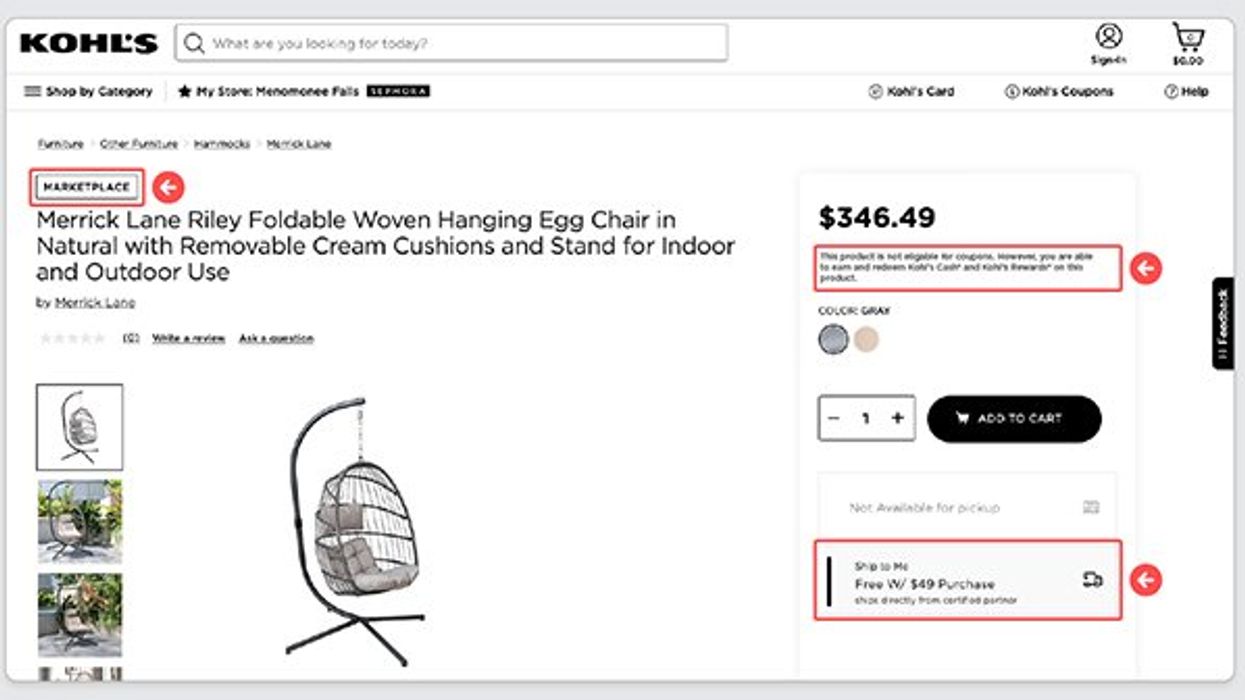Retail Channels
30 March 2023
Kohl's grows third-party marketplace following pilot phase
The retailer is also working to expand its retail media network.

Kohl's marketplace. (Courtesy photo)
The retailer is also working to expand its retail media network.

Kohl's marketplace. (Courtesy photo)
Kohl’s is making more items available on its marketplace as the department store retailer seeks to drive digital growth.
The news: Kohl’s is moving its marketplace out of pilot mode. With the official launch following what it called a "successful" test period, the retailer is adding more items to the assortment of thousands of items from third-party marketplaces.
What’s available? Kohl’s said it is opening the marketplace to sellers in all years. In particular, it is looking to emphasize the following categories:
How are they identified? On its ecommerce store, Kohl’s denotes marketplace items with a badge. Items are shipped directly from sellers.
Key quote: On the company’s Q4 earnings call, Kohl’s CEO Tom Kingsbury talked about the retailer’s push to grow a digital business that accounts for 30% of sales. “Two of our key digital growth initiatives include expanding Kohl's Marketplace and Kohl's media network," Kingsbury said. "Kohl's Marketplace is broadening our product offering online to capture incremental sales opportunities, and Kohl's media network is leveraging our digital platform and site traffic to partner with more of our key brands and capture more advertising dollars.”
Marketplace moment: Kohl’s is the latest retailer to stand up a third-party marketplace in recent months, joining Macy’s and Michaels, among others. Amazon perfected the marketplace model as a means to grow its assortment and in turn drive price advantages. Now, retailers with well-trafficked websites are adopting it across the industry. The marketplace also opens up advertising opportunities. It wasn’t a mistake that Kingsbury talked about Kohl’s marketplace and media network in the same statement. More items on a marketplace will bring more of a desire for brands to stand out. That means they are more likely to buy advertising to improve placement. For Kohl’s the retail media network opens up a high-margin, digital business line that can exist alongside selling physical goods.Labor disputes on the West Coast could cause further disruption heading into peak season.
When the first half of 2023 is complete, imports are expected to dip 22% below last year.
That’s according to new data from the Global Port Tracker, which is compiled monthly by the National Retail Federation and Hackett Associates.
The decline has been building over the entire year, as imports dipped in the winter. With the spring, volume started to rebound. In April, the major ports handled 1.78 million Twenty-Foot Equivalent Units. That was an increase of 9.6% from March. Still it was a decline of 21.3% year over year – reflecting the record cargo hauled in over the spike in consumer demand of 2021 and the inventory glut 2022.
In 2023, consumer spending is remaining resilient with in a strong job market, despite the collision of inflation and interest rates. The economy remains different from pre-pandemic days, but shipping volumes are beginning to once again resemble the time before COVID-19.
“Economists and shipping lines increasingly wonder why the decline in container import demand is so much at odds with continuous growth in consumer demand,” said Hackett Associates Founder Ben Hackett, in a statement. “Import container shipments have returned the pre-pandemic levels seen in 2019 and appear likely to stay there for a while.”
Retailers and logistics professionals alike are looking to the second half of the year for a potential upswing. Peak shipping season occurs in the summer, which is in preparation for peak shopping season over the holidays.
Yet disruption could occur on the West Coast if labor issues can’t be settled. This week, ports from Los Angeles to Seattle reported closures and slowdowns as ongoing union disputes boil over, CNBC reported. NRF called on the Biden administration to intervene.
“Cargo volume is lower than last year but retailers are entering the busiest shipping season of the year bringing in holiday merchandise. The last thing retailers and other shippers need is ongoing disruption at the ports,” aid NRF Vice President for Supply Chain and Customs Policy Jonathan Gold said. “If labor and management can’t reach agreement and operate smoothly and efficiently, retailers will have no choice but to continue to take their cargo to East Coast and Gulf Coast gateways. We continue to urge the administration to step in and help the parties reach an agreement and end the disruptions so operations can return to normal. We’ve had enough unavoidable supply chain issues the past two years. This is not the time for one that can be avoided.”